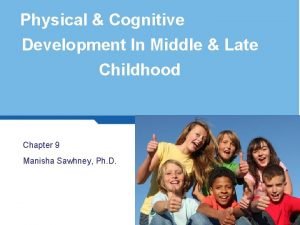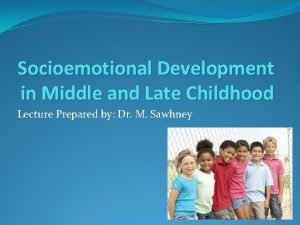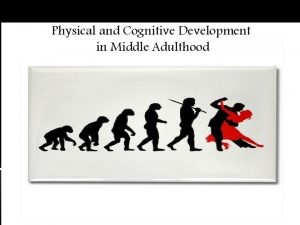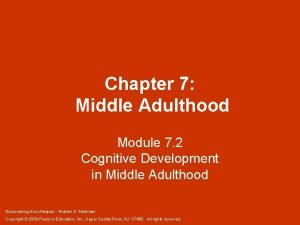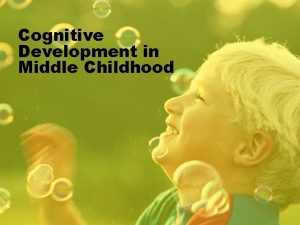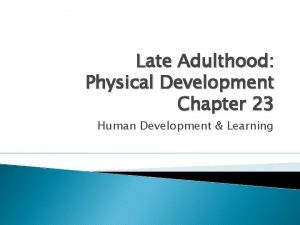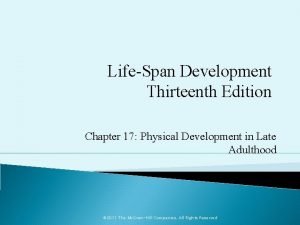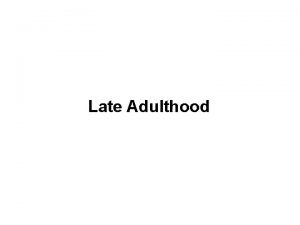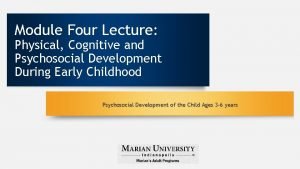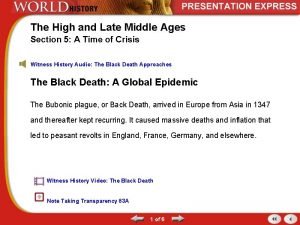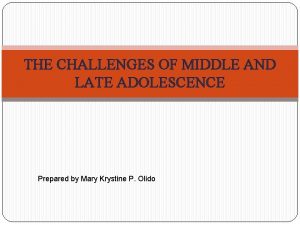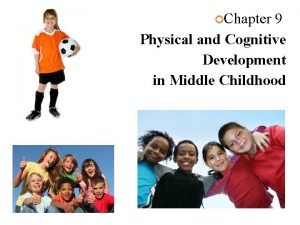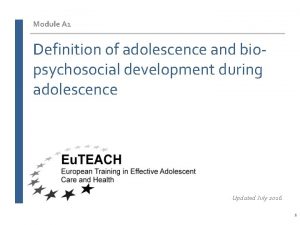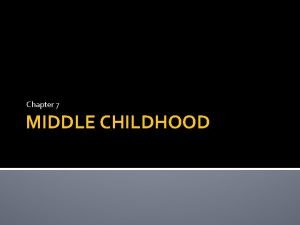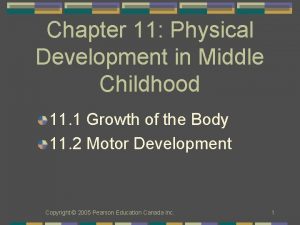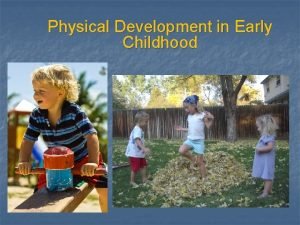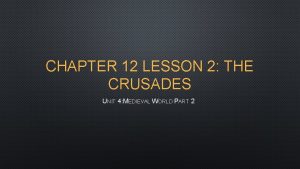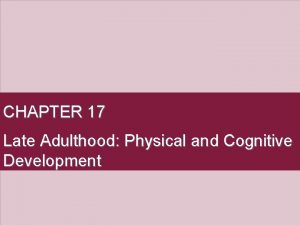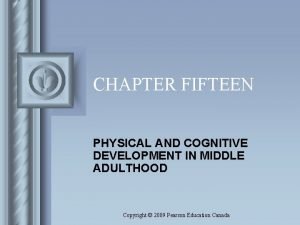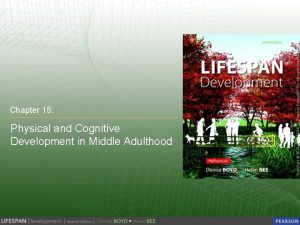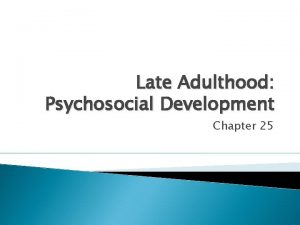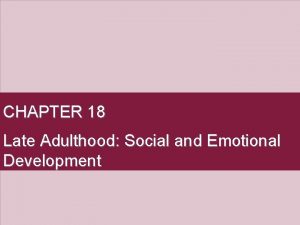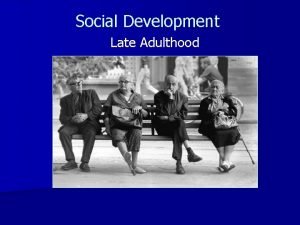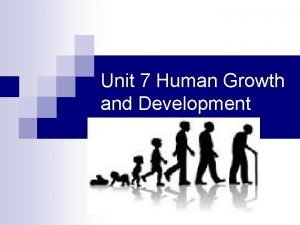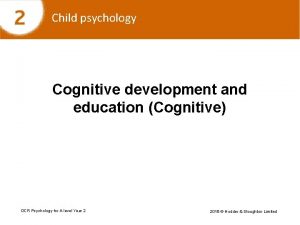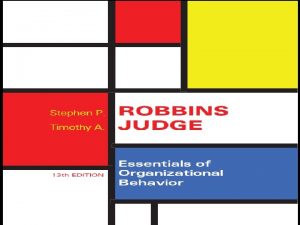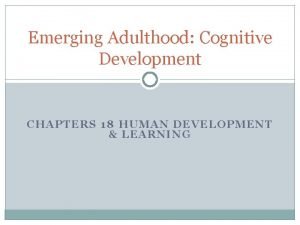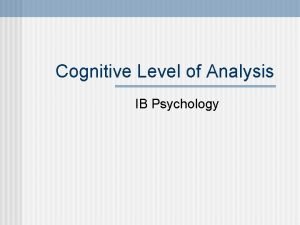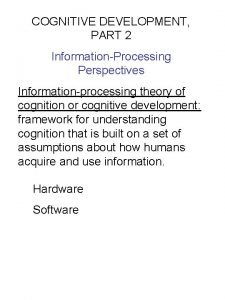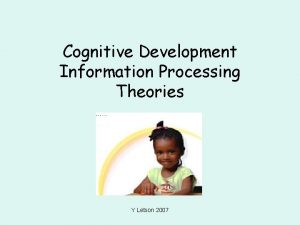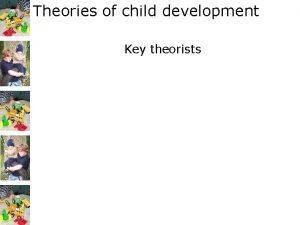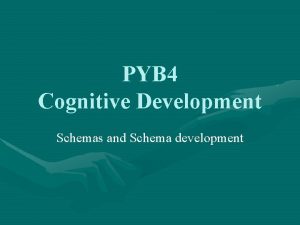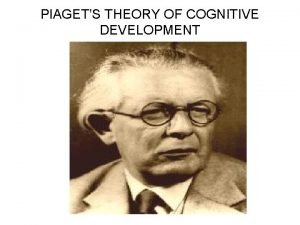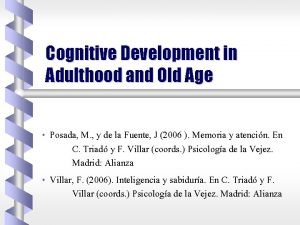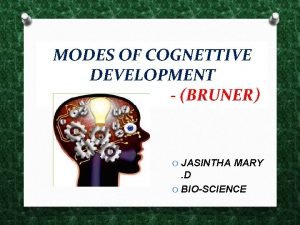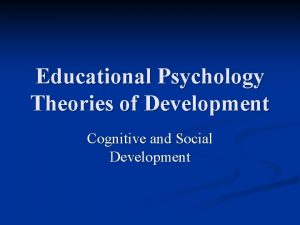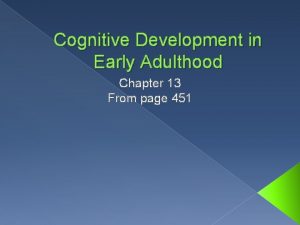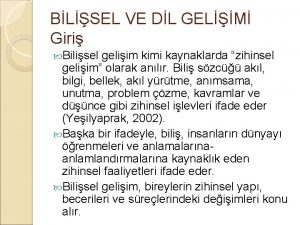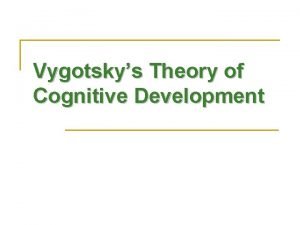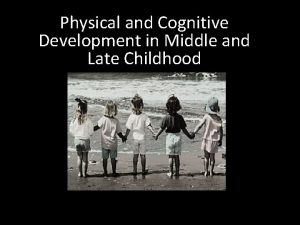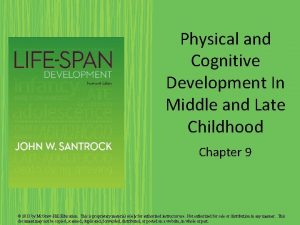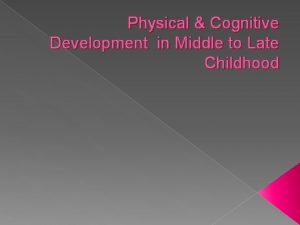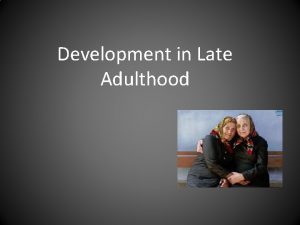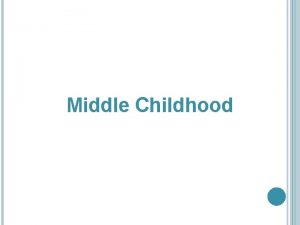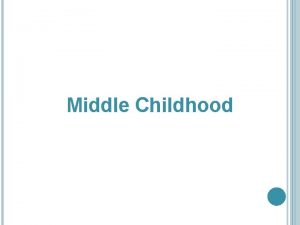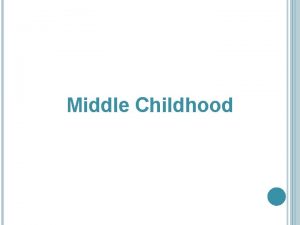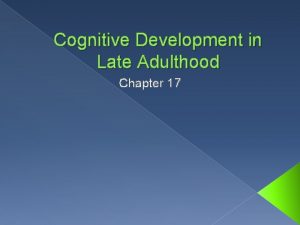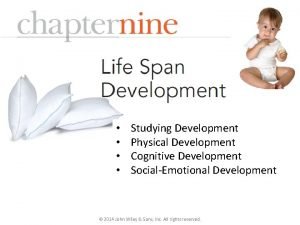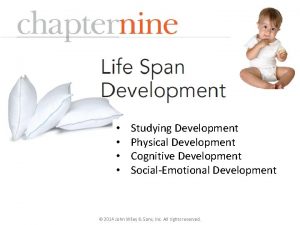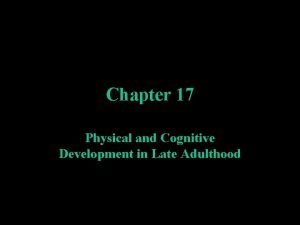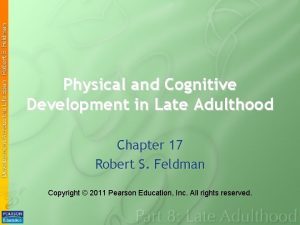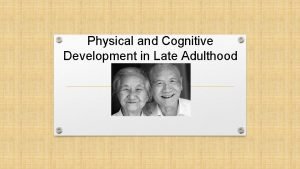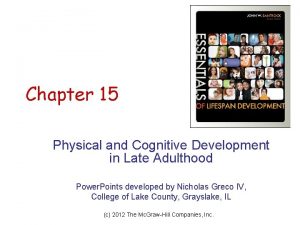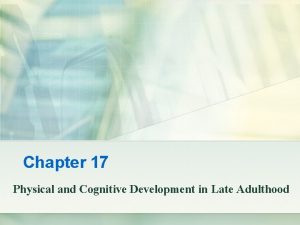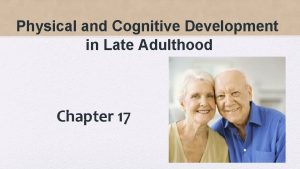Physical and Cognitive Development in Middle and Late

































































- Slides: 65

Physical and Cognitive Development in Middle and Late Childhood

Body Growth and Change: �Growth averages 5– 7 cms per year �Weight gain averages 2. 3– 3. 3 kgs each year �Muscle mass and strength gradually increase; baby fat decreases �Ossification of bones �Boys have a greater number of muscle cells and are typically stronger than girls

Body Growth and Change The Brain: �Brain volume stabilizes �Significant changes in structures and regions occur, especially in the prefrontal cortex Improved attention, reasoning, and cognitive control �Increases in cortical thickness �Activation of some brain areas increase while others decrease Shift from larger areas to smaller, more focal areas Due to synaptic pruning

Body Growth and Change Motor Development: �Gross motor skills become smoother and more coordinated Boys usually outperform girls on gross motor skills �Improvement of fine motor skills during middle and late childhood Increased myelination of the central nervous system Girls usually outperform boys on fine motor skills

Exercise plays an important role in children’s growth and development Percentage of children involved in daily P. E. programs in schools decreased from 80% (1969) to 20% (1999) Television watching is linked with low activity and obesity in children

Health, Illness, and Disease • Middle and late childhood is usually a time of excellent health – Injuries are the leading cause of death during middle and late childhood • Motor vehicle accidents are most common cause of severe injury – Cancer is the 2 nd leading cause of death in children 5– 14 years old • Most common child cancer is leukemia – Many elementary-school children already possess risk factors for cardiovascular disease

Health, Illness, and Disease Overweight Children: �Being overweight as a child is a risk factor for being obese as an adult Girls are more likely than boys to be overweight �Changes in diet and total caloric intake may be one reason for increasing obesity rates

�Raises risks for many medical and psychological problems Pulmonary problems, diabetes, high blood pressure Low self-esteem, depression, exclusion from peer groups

Learning Disabilities • Definition of learning disability includes three components: – Minimum IQ level – Significant difficulty in a school-related area – Exclusion of • • Severe emotional disorders Second-language background Sensory disabilities Specific neurological deficits

• Boys are identified three times more frequently than girls • Most common form involves reading (i. e. , dyslexia)


Learning Disabilities Possible Causes: �Genetics (many tend to run in families) �Environmental influences �Problems in integrating information from multiple brain regions �Difficulties in brain structures and functions Intervention: �Improving reading ability through intensive instruction

Learning Disabilities ADHD �Characterized by �Inattention �Hyperactivity �Impulsivity �Number of children diagnosed has increased significantly

Possible Causes: �Genetics �Brain damage during prenatal or postnatal development �Cigarette and alcohol exposure during prenatal development �Later peak for cerebral cortex thickening

Learning Disabilities ADHD Treatment: �Stimulant medication (Ritalin or Adderall) is helpful (methylphenidate) �Combination of medication and behavior management seems to work best �Exercise may reduce ADHD symptoms Critics argue that physicians are too quick to prescribe medications

Learning Disabilities Autism Spectrum Disorders � 1 million American children �Ranging from severe autistic disorder milder Asperger syndrome �Detected as early as 1 -3 years of age �Boys 4 x likely to have the disorder �IQ range from MR to average and above average intelligence

Cognitive Changes Piaget’s Concrete Operational Stage: Ages 7 to 11 Children can perform concrete operations and reason logically Ability to classify things into different sets and consider their interrelationships

Concrete Operational Thought • Mental actions that allow the child to do mentally what was physically done before. • Concrete Operations are also mental actions that are reversible. • Example- The clay roll test

Memory: Long-term memory increases with age during middle and late childhood �Influences how they organize, represent, and interpret information �Affects ability to remember, reason, and solve problems �Older children usually have more expertise about a subject than younger children do

Thinking Critical Thinking: Thinking reflectively and productively, and evaluating evidence �Is it functioning in the schools? - Open-mindedness - Intellectual curiosity - Planning and strategy - Intellectual carefulness

Creative Thinking: The ability to think in novel and unusual ways, and to come up with unique solutions to problems �Convergent thinking: produces one correct answer �Divergent thinking: produces many different answers to the same question

Intelligence • Intelligence: • Intelligence is verble ability, Problem-solving skills and the ability to learn from and adapt to life’s everyday experiences • Individual Differences: – Stable, consistent ways in which people are different from each other

Intelligence • Intelligence Tests: – Binet Tests: designed to identify children with difficulty learning in school • Mental age (MA): an individual’s level of mental development relative to others • Intelligence quotient (IQ): a person’s mental age divided by chronological age, multiplied by 100 – Stanford-Binet Tests: revised version of the Binet test • Scores approximate a normal distribution—a bell-shaped curve – Wechsler Scales: give scores on several composite indices • Three versions for different age groups

Intelligence quotient (IQ)

Intelligence quotient (IQ) IQ Score Over 140 120 - 139 110 - 119 90 - 109 80 - 89 70 - 79 50 - 69 20 - 49 Below 20 Binet Scale of Human Intelligence Original Name Modern Term Genius or Near-Genius Very Superior Average or Normal Dull Normal Borderline Mild Deficiency Moron Moderate Imbecile Severe Idiot Profound

Intelligence Types of Intelligence Sternberg’s Triarchic Theory of Intelligence: intelligence comes in three forms: Componential Intelligence: Ability to analyze, judge, evaluate, compare, and contrast Experiential intelligence: Ability to create, design, invent, originate, and imagine Contextual intelligence: Ability to use, apply, implement, and put ideas into practice

Intelligence Types of Intelligence (continued): �Gardner’s Eight Frames of Mind: Verbal: ability to think in words and use language to express meaning Mathematical: ability to carry out mathematical operations Spatial: ability to think threedimensionally Musical: sensitivity to pitch, melody, rhythm, and tone Interpersonal: ability to understand interact effectively with others Intrapersonal: ability to understand oneself Naturalist: ability to observe patterns in nature and understand natural and human-made systems

Differences in IQ Scores Environmental Influences: Communication of parents Schooling Flynn Effect: rapidly increasing IQ test scores around the world Increasing levels of education attained by more people Explosion of available information Interventions designed to help children at risk for impoverished intelligence

Differences in IQ Scores Group Differences: On average, African American schoolchildren score 10 to 15 points lower on IQ tests than White American schoolchildren Gap has begun to narrow as African Americans have gained social, economic, and educational opportunities

Differences in IQ Scores

Differences in IQ Scores • Extremes of Intelligence: – Mental Retardation: • A condition of limited mental ability in which an individual has a low IQ (typically below 70) and has difficulty adapting to everyday life – Can be mild, moderate, severe or profound • Mildly retarded makes up 85% of MR population – Can have an organic cause, or it can be social and cultural in origin

Intelligence (IQ) vs. Emotional Intelligence (EQ) • IQ is primarily used to measure one's cognitive abilities, – such as the ability to learn or understand new situations; – how to reason through a given problem/scenario; – the ability to apply knowledge to one's current situations. – It involves primarily the neo cortex or top portion of the brain. • EQ - A measure of one's emotional intelligence, – as defined by the ability to use both emotional and cognitive thought. – Emotional intelligence skills include but are not limited to empathy, intuition, creativity, flexibility, resilience, stress management, leadership, integrity, authenticity, intrapersonal skills and interpersonal skills. – It involves the lower and central sections of the brain, called the limbic system

• "It is not the strongest of the species that survives, nor the most intelligent, but the one most responsive to change. " - Charles Darwin

Socioemotional Development in Middle and Late Childhood

The Self • Development of Self Understanding – During middle and late childhood: • Defining one’s “self” shifts from using external characteristics to using internal characteristics or personality traits. • Children recognize social aspects of the self. • Social comparison increases

The Self • Understanding Others Children show an increase in perspective taking (ability to assume another persons point of view and understand their thoughts and feelings) Especially important for the development of prosocial or antisocial attitudes and behavior Children become increasingly skeptical of others’ claims ( having doubt)

The Self • Self Esteem: – Global evaluations of the self • Self Concept: – Domain-specific evaluations of the self • Beliefs about self esteem do not always match reality • Most studies about self esteem are correlation (cannot determine causation)

The Self • Children with high self esteem – Do not seem to perform better in school – Have greater initiative (can be positive or negative) – Are prone to both prosocial and antisocial actions

The Self • Four Ways to Improve Self Esteem – Identify causes of low self esteem – Provide emotional support and social approval – Help child achieve – Help child cope

The Self • Self Efficacy: – Belief that one can master a situation and produce favorable outcomes – Students with low self efficacy often avoid challenging • Self Regulation: – Increased capacity for self-regulation in middle and late childhood – Linked to development advances in the prefrontal cortex

The Self • Industry vs. Inferiority (Erickson) – Industry: • Children become interested in how things work – Inferiority: • Parents who see their children’s efforts as mischief may encourage inferiority – School is very important in the development of a sense of industry

Emotional Development • Developmental Changes Include: – Improved emotional understanding – Increased understanding that more than one emotion can be experienced in a particular situation – Increased awareness of the events leading to emotional reactions – Ability to suppress or conceal negative emotional reactions – Use of self-initiated strategies for redirecting feelings – A capacity for genuine empathy

Emotional Development • Coping with Stress: – Older children utilize more coping strategies – Coping with stressful events: • Reassure children • Allow children to retell events • Encourage children to talk about feelings • Protect children from re-exposure • Help children make sense of what happened

Moral Development • Morality – The differentiation of – Intentions – Decisions, and – actions – between those that are good (or right) and those that are bad (or wrong).

Lawrence Kohlberg’s Theory Punishment & obedience Reward stage Peer pressure stage Law and Order by the legal order People have own moral principles but willing to sit down and resolve discrepancies that other’s have • Dr. Martin Luther King, Jr. felt higher law than law of land, transcended higher law, willing to take risks because felt strong belief in ultimate moral principle • • •

Moral Development • Lawrence Kohlberg’s Theory: – Extended Piaget’s basic theory – Proposed 6 universal states of moral development. – Developed stages based on interviews using moral dilemmas – Before age 9, most children use level 1 – Most adolescents reason at stage 3 – By early adulthood, a few use postconventional reasoning

Moral Development

Moral Development • Research on Kohlberg’s Theory: – Stage 1 and 2 use decrease with age – No 10 year olds (but 62% of 32 year olds) use level 4 – Stage 5 did not appear until age 20 to 22 – Stage 6 reasoning is very rare

Criticisms of Kohlberg’s Theory • Kohlberg’s theory may reflect a gender bias (Carol Gilligan) – Kohlberg promotes a justice perspective – Gilligan argues for a caring perspective • Gilligan and colleagues found that women consistently interpret moral dilemmas differently than men – Experts now believe there is no evidence to support Gilligan’s claim

Gender - Cognitive Development • Men tend to have better math and visuospatial skills – (the ability to see and analyze objects in relation with their surroundings), – but difference are small • Females tend to perform better than males on reading and writings tasks

Gender - Socioemotional Development • Aggression: – Boys are more physically aggressive than girls – Girls show as much verbal aggression as boys – Girls engage in relational aggression • (harm is caused through damage to one’s relationships or social status) more often than physical aggression

Gender - Socioemotional Development • Emotion: – Girls admit to feeling • sadness • shame • guilt – boys tend to deny that they experience these emotions – Males show less emotional self-regulation • Prosocial Behavior: – Females engage in more prosocial behavior than males

Gender Role Classification • Masculinity and femininity used to be described as a continuum – This view challenged by the concept of androgyny (presence of positive masculine and feminine traits in the same person) • Androgynous individuals are more – Flexible – Competent – mentally healthy

Peers • Positive relationships with peers are especially important in middle and late childhood • Developmental Changes: – Reciprocity (A mutual or cooperative interchange) becomes increasingly important in peer interchanges during elementary school – Size of peer group increases. – Peer interaction is less closely supervised by adults – Children’s preference for same-sex peer groups increases until about age 12

Peers Popular Children: �Give out reinforcements �Listen carefully; maintain open lines of communication with peers �Are happy �Control their negative emotions �Show enthusiasm and concern for others �Are self confident without being conceited (Holding or characterized by an unduly high opinion of oneself)

Peers Neglected Children: �Engage in low rates of peer interaction �Often described as shy

• Rejected Children: – Often have more serious social adjustment problems than neglected children – Often find that rejection increases aggressive behavior over time • More impulsive • More emotionally reactive • Fewer social skills

Bullying • Aggressive behavior manifested by the use of force or coercion to affect others • Boys and younger middle school students are most likely to be affected • Child victims often tend to: – Be lonely and have difficulty making friends – Be anxious, socially withdrawn, aggressive • Child bullies often tend to: – Have low grades in school – Use alcohol and/or tobacco

Bullying • Outcomes of bullying: – More likely to experience depression and attempt suicide – More health problems • • Headaches Dizziness sleep problems anxiety)

Friends • Children’s friendships are typically characterized by similarity • Six functions: – Companionship – Stimulation – Physical support – Ego support – Social comparison – Affection (love) and intimacy (involved in a sexual relationship

Schools Constructivist Approach: learner-centered approach emphasizes the importance of individuals actively constructing their own knowledge and understanding Emphasis on collaboration and active learning • Direct-Instruction Approach: structured, teacher-centered approach – Teacher direction and control – High teacher expectations for students’ progress – Maximum time spent by students on academic tasks Combination of both approaches may be best

Schools • No Child Left Behind Legislation (2002): – That testing will: • Improve student performance • Encourage teachers to spend more time teaching the subjects that are tested • Raise expectations for students • Identify poorly performing schools, teachers, and administrators • Improve confidence in schools

QUESTIONS

Every forward step we take we leave some phantom of ourselves behind” -JOHN LANCASTER SPALDING American educator

THANK YOU…
 Late childhood
Late childhood Middle and late childhood physical development
Middle and late childhood physical development Late adulthood mental development
Late adulthood mental development Socioemotional development in middle and late childhood
Socioemotional development in middle and late childhood Cognitive development in middle adulthood
Cognitive development in middle adulthood Middle adulthood cognitive development
Middle adulthood cognitive development Cognitive development in middle childhood
Cognitive development in middle childhood Late adulthood physical development
Late adulthood physical development Physical changes in late adulthood
Physical changes in late adulthood Adulthood development stages
Adulthood development stages Physical and cognitive development in early adulthood
Physical and cognitive development in early adulthood Physical and cognitive development in early adulthood
Physical and cognitive development in early adulthood Define physical cognitive and psychosocial development
Define physical cognitive and psychosocial development Cognitive and non cognitive religious language
Cognitive and non cognitive religious language The high and late middle ages section 5 quiz
The high and late middle ages section 5 quiz The challenges of middle and late adolescence
The challenges of middle and late adolescence Early and middle childhood
Early and middle childhood Middle and late childhood
Middle and late childhood Middle adolescence physical development
Middle adolescence physical development Filial maturity
Filial maturity Physical development in middle childhood
Physical development in middle childhood Physical changes in adulthood
Physical changes in adulthood Physical development in middle childhood chapter 11
Physical development in middle childhood chapter 11 Physical development in middle childhood
Physical development in middle childhood Late middle ages timeline
Late middle ages timeline Copyright
Copyright Chapter 12 lesson 2 the crusades answer key
Chapter 12 lesson 2 the crusades answer key Social and emotional development in late adulthood
Social and emotional development in late adulthood Changes in late adulthood
Changes in late adulthood Denny's model of physical and cognitive ageing
Denny's model of physical and cognitive ageing Denny's model of physical and cognitive ageing
Denny's model of physical and cognitive ageing Late adulthood psychosocial development
Late adulthood psychosocial development Social changes in middle adulthood
Social changes in middle adulthood Robert peck developmental tasks
Robert peck developmental tasks Disengagement theory
Disengagement theory Social development in late childhood
Social development in late childhood Forms of development
Forms of development Emotional development in late adulthood
Emotional development in late adulthood Module 47 infancy and childhood cognitive development
Module 47 infancy and childhood cognitive development Education cognitive development
Education cognitive development Module 47 infancy and childhood cognitive development
Module 47 infancy and childhood cognitive development Chapter 5 cognitive development in infancy and toddlerhood
Chapter 5 cognitive development in infancy and toddlerhood Self-determination theory
Self-determination theory Gerome bruner
Gerome bruner Information processing theory of cognitive development
Information processing theory of cognitive development Emerging adulthood cognitive development
Emerging adulthood cognitive development Cognitive levels of development
Cognitive levels of development Cognitive development characteristics
Cognitive development characteristics Information processing theory of cognitive development
Information processing theory of cognitive development Information processing theory of cognitive development
Information processing theory of cognitive development Vygotsky theory definition
Vygotsky theory definition Schema cognitive development
Schema cognitive development Conclusion of piaget's theory
Conclusion of piaget's theory A vygotskian classroom promotes ________.
A vygotskian classroom promotes ________. Cognitive development in old age
Cognitive development in old age Conclusion of cognitive development
Conclusion of cognitive development Cognitive theory child development
Cognitive theory child development Piaget's preoperational stage
Piaget's preoperational stage Bruner's theory of cognitive development
Bruner's theory of cognitive development Vygotsky theory
Vygotsky theory Information processing theory of dreams
Information processing theory of dreams Cognitive changes in early adulthood
Cognitive changes in early adulthood Features of cognitive development
Features of cognitive development Psychsim 5 cognitive development
Psychsim 5 cognitive development Piaget ve vygotsky dil gelişim karşılaştırılması
Piaget ve vygotsky dil gelişim karşılaştırılması Vygotsky's theory of cognitive development
Vygotsky's theory of cognitive development

